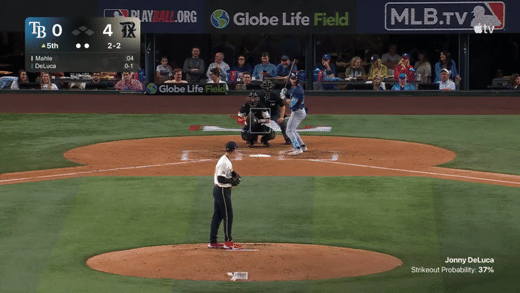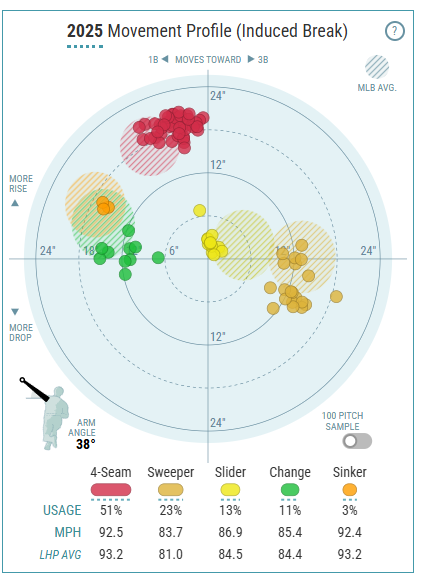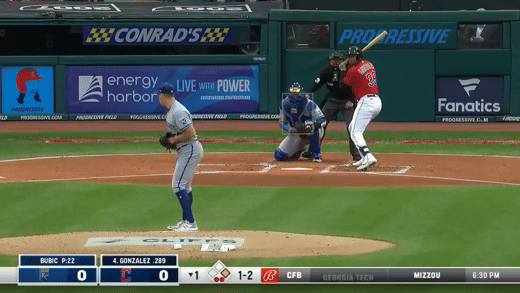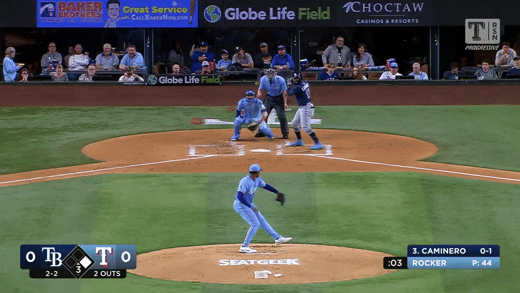Elliott looks at pitchers with surprising starts recently. These SPs could emerge as fantasy baseball waiver wire targets for Week 2 in 2025, or just mirages.
Welcome back to the "Are You For Real?" series as we dive into Week 1 of the 2025 fantasy baseball season. It feels so good to be back! For those who are not familiar, this is a weekly column where we take starting pitchers who had surprisingly good starts over the past week and put them under the microscope to determine whether they're legit or just smoke and mirrors.
We've got three AL arms to look at this week. First, we'll look at the return of right-hander Tyler Mahle in Texas; then, we'll break down a strong start from Kris Bubic. We'll finish it off by deep-diving a solid outing from Kumar Rocker against the Rays.
Roster percentages are taken from Yahoo! and are accurate as of April 7.
Be sure to check all of our fantasy baseball lineup tools and resources:- Fantasy baseball trade analyzer
- BvP matchups data (Batter vs. Pitcher)
- PvB matchups data (Pitcher vs. Batter)
- Who should I start? Fantasy baseball comparisons
- Daily MLB starting lineups
- Fantasy baseball closer depth charts
- Fantasy Baseball live scoreboard
- Fantasy baseball injury reports
Tyler Mahle, Texas Rangers - 4% Rostered
2024 Stats: 12 2/3 IP, 4.97 ERA, 3.80 FIP, 10.7 percent K-BB%
4/4 vs. TB: 5 IP, 1 H, 0 ER, 2 BB, 5 K
Mahle announced his return to the mound in a big way on Friday, blanking the Rays and holding them to just one hit over five innings en route to his first victory of the season. Mahle struggled with control in his first start of the season issuing four walks in 1.2 innings, but he bounced back against Tampa Bay. Mahle was once considered a fantasy asset just a few short years ago, but injuries have derailed his career trajectory. Is he back to being fantasy-relevant, or should you leave him on the wire?
Originally a seventh-round draft pick by the Reds back in 2013, Mahle did garner some prospect hype thanks to strong minor league performances. He struggled initially in the majors but found his footing in his mid-20s. Between 2020 and 21, Mahle pitched 227.2 innings with a 3.72 ERA, 3.82 FIP, and 19.3 percent K-BB%. Not bad, especially considering he’s a flyball pitcher who was pitching half his games in the Great American Ball Park. Unfortunately, he made just eight total starts between 2023 and 2024 after undergoing Tommy John surgery.
Mahle works with a four-pitch mix consisting of a four-seam fastball, splitter, slider, and cutter. All four pitches were on display against Tampa Bay, but he relied heavily on the fastball and splitter in this outing, throwing the two pitches a combined 80 percent of the time. That deviates from his pitch sequencing during his peak years, where Mahle relied more on the slider. The splitter looks to be taking over as Mahle’s primary off-speed pitch.
An 84-mph offering, Mahle’s splitter is a low-spin split-change, averaging just 1,710 rpm thus far this year. He has a slightly above-average horizontal break with the pitch, making it effective against both righties and lefties. Here’s an example from this start.

It looks good there, but sadly, what you just watched was Mahle’s only swinging strike with the splitter during this outing. He got one whiff on 15 swings, suitable for a measly seven percent whiff rate. Mahle has gotten better strikeout numbers with his splitter in past seasons, so perhaps getting just one whiff was a fluke. He has a 13.9 percent swinging strike rate and a 34.6 percent chase rate with his splitter all-time, so there’s hope that Mahle can get more whiffs with the pitch down the road.
The Rays do not strike out often against right-handed pitching either, with an 18.7 percent strikeout rate collectively vs. RHP this season as of 4/5/25, the fifth-lowest in the majors. It’s impressive that Mahle got 13 total whiffs and five strikeouts against Tampa Bay, including seven whiffs with his fastball and four with his slider.
Curiously, Mahle doesn’t throw his slider more frequently. It was his primary breaking ball during his peak in the early 2020s, and he had a 67 percent whiff rate with it in this outing. The slider has below-average movement and has had diminishing results over the past few seasons, albeit in limited action for Mahle.
His slider hasn’t had a swinging strike rate above 11 percent since 2022, and the all-time chase rate is just 25 percent. Perhaps this is why Mahle decided to lean on the splitter more frequently since coming to Texas. The slider was successful against Tampa Bay, and I wouldn’t mind seeing him incorporate the pitch more often against right-handed batters. He doesn’t need to throw his fastball and splitter a combined 80 percent of the time; he can mix in his slider and cutter more often, too.
One area of concern with Mahle is his fastball velocity. It was down in this start as he averaged just 92.3 mph. He averaged over 93 mph in his first start and sat at 94 during his peak. Mahle may never return to peak velocity, but he could still find effectiveness with his fastball. He has plus movement with the pitch, giving it a good shape that batters routinely swing under and hit into the air. Mahle routinely has an average launch angle against his fastball that’s greater than 20 degrees.
He has a 41.1 percent flyball rate and a 23 percent infield flyball rate against the pitch for his career. This is great for inducing weak hits and easy outs, but flyball pitchers often play with fire, especially in Texas. Mahle has a bloated 1.36 HR/9 for his career, and while Globe Life Field is technically better than Great American Ball Park for home runs, it still had a 115 HR factor last year, the fourth-highest in MLB. Mahle will surrender his fair share of longballs this year.
Verdict:
Ultimately, Mahle’s stuff is rather average, and he might struggle to recapture past strikeout numbers, especially if he chooses to lean on the splitter over the slider as he has thus far. I’d expect better control from him going forward, as that had been a strength at times in the past. He will be susceptible to home runs, given his home ballpark and flyball tendencies. Mahle is best used as a matchup-based streamer in standard leagues. His next start comes at the Cubs, and I’d probably avoid him there. The Cubs have a .328 wOBA and 117 wRC+ against right-handed pitchers this season.
Kris Bubic, Kansas City Royals - 55% Rostered
2024 Stats (bullpen): 30 1/3 IP, 2.67 ERA 1.95 FIP, 28.1 percent K-BB%
4/6 vs. BAL: 6 2/3 IP, 5 H, 1 ER, 1 BB, 8 K
Bubic was electric on Sunday, fanning eight Orioles en route to his second victory of the season. Bubic now has a 0.71 ERA and 11.37 K/9 through his first two starts, and he struck out exactly eight batters in back-to-back outings. The southpaw reentered the Royals rotation after spending last season reinventing himself in the bullpen. Is the new and improved Bubic a fantasy asset or a mirage?
Originally taken 40th overall in the 2018 draft during the competitive balance rounds, Bubic had some decent prospect pedigree coming up. He was part of a group of Royals pitching prospects who came up in the early 2020s, and Bubic floundered at first. In fact, prior to this season, Bubic had a 4.99 ERA, 4.92 FIP, and a 10.2 percent K-BB% in 60 career starts. Those are not exactly numbers to get excited about.
Things went off the rails when Bubic needed Tommy John surgery in 2023. It seemed like the Bubic experiment might be over, but Bubic returned to a bullpen role and was outstanding. He had a 2.67 ERA, 1.95 FIP, and a monster 7.8 K/BB ratio in 27 appearances last season. Is he bringing that success into the rotation?
Bubic works with a four-pitch mix consisting of a four-seam fastball, sweeper, changeup, slider, and sinker. His changeup is arguably his best pitch, but let’s start with the fastball, as Bubic has been doing some interesting things with this pitch. First, we’ve seen him gain velocity upon returning from Tommy John surgery.
He threw about 91 mph pre-surgery but averaged 93 mph on the gun last season. It’s normal for pitchers to throw harder out of the bullpen since they can let it rip for one or two innings at a time, but Bubic has carried those velocity gains into the rotation. He’s averaged 92.5 mph through his first two starts at an average of 92 mph exactly against Baltimore. Maybe he won’t be able to sit 93, but he still throws it harder.
Velocity is just one improvement that Bubic made to his fastball. He also changed his release point and increased the amount of vertical break with the pitch. Let’s compare his fastball shape from his last full season as a starter, 2022, to his fastball shape through two starts this season.


He has added two additional inches of induced vertical break and is fooling batters more frequently with the pitch. He had a 15.5 percent swinging-strike rate with the pitch last season and has a 15.4 percent swinging-strike rate with the pitch so far.
Bubic made these changes by altering his release point and changing his arm angle. Let’s compare a Bubic fastball from 2022 to one from this season.
2022:

2025:

Notice how his arm slot is lower, and his delivery isn’t as over-the-top as it was back in 2022. Bubic has made tangible changes to his delivery, and the results have been there thus far. It might be difficult for him to maintain a 15.4 percent swinging-strike rate with a 92 mph fastball over an entire season, but it’s a new and improved pitch, regardless.
The fastball isn’t the only impressive offering we have from Bubic, either. His changeup was on fire in this outing, earning eight of his 16 whiffs on 11 swings, which is good for a monster 73 percent whiff rate. With a low-spin, 85-mph offering, Bubic’s changeup boasts above-average vertical and horizontal movement. Batters struggled against this pitch last season, hitting just .179 with a .286 SLG and .214 wOBA, along with a 34.1 percent whiff rate. Here’s an example of the pitch from this start.

If you’re making renowned lefty-masher Tyler O'Neill look like that, you’re doing something right as a southpaw. Bubic used the pitch 20 percent of the time in this outing after using it just 10 percent of the time against Milwaukee. We’d like to see him in that 20-25 percent usage range, as the changeup is his best pitch and should earn him the most strikeouts.
What about the rest of his arsenal? Bubic added a sweeper upon returning from Tommy John surgery. It’s a softer, higher spin offering than his slider, averaging 83.9 mph and 2,617 rpm last season. It had mixed results in 2023, with batters hitting .293 off the pitch with a .317 SLG and .261 wOBA, but opponents also had a .204 xBA, .253 xSLG, and .197 xwOBA last year.
He also had a 26.1 percent whiff rate with the pitch last season, which is okay for a tertiary option but doesn’t exactly blow anyone away. He did have a 33 percent whiff rate with the pitch in this start, so perhaps there’s room for growth. He threw his slider more often than his sweeper against Baltimore (20 vs. 13 percent), and he’s probably best served mixing them both in as complements to his fastball and changeup.
Verdict:
Bubic was a hot sleeper coming into the season, and yours truly was among those on the bandwagon. I loved Bubic coming into the season, and I am fully ready to succumb to confirmation bias and call this an absolute win.
In all seriousness, Bubic has made some great improvements to his game, and there’s plenty of reason to believe he’s a breakout in the making. His fastball looks better; he changed his arm slot, his changeup is still lights out, and he’s added a sweeper. Bubic is a must-add in all formats, at least as a speculative pick-up. Don’t expect eight strikeouts every time, but there could be something special here.
Kumar Rocker, Texas Rangers - 38% Rostered
2024 Stats: 11 2/3 IP, 3.86 ERA, 3.68 FIP, 14.5 percent K-BB%
4/7 vs. TB: 5 IP, 6 H, 1 ER, 0 BB, 1 K
Rocker bounced back nicely after getting shelled for six runs against Cincinnati in his first start of the season. He held Tampa Bay to just one run over five innings. He only had one strikeout, but he also didn’t walk a batter and limiting walks has been a challenge for Rocker at times. With injuries to Jack Leiter, Jon Gray, and Cody Bradford, there’s room for Rocker to stick around the rotation if he performs. Is there any fantasy value to be had here, or will Rocker rock our ratios?
Originally the third overall pick in 2022, Rocker was a big-name prospect coming out of Vanderbilt alongside fellow right-hander Leiter. He still had some prospect pedigree coming into the season, with FanGraphs ranking him as the No. 74 prospect in baseball on their post-spring training update on 3/31/25. Rocker works with a five-pitch mix consisting of a four-seam fastball, slider, sinker, curveball, and changeup.
He may have five pitches to choose from, but it was mostly about just two against Tampa Bay: the sinker and the slider. He threw those pitches a combined 83 percent of the time on Sunday. This represents the most Rocker has thrown his sinker in any major league start by a good margin. He threw the pitch 50.6 percent of the time in this outing, while his previous high was 21.1 percent. Could this be a new approach?
Rocker is a hard thrower, averaging 95.5 mph with his sinker in this outing. With plus horizontal movement, Rocker’s sinker has a good shape that batters often swing over, leading to groundballs. Groundballs are something that Rocker has excelled at inducing, with his groundball rate routinely above 50 percent at his various minor league stops. That’s a good trait to have for pitchers in Texas, as we previously discussed Globe Life Field being a homer haven.
Perhaps Rocker used his sinker more frequently because his four-seamer has gotten crushed at the major league level. It’s a limited sample size, just five starts total, but batters have pulverized the pitch. Opponents are hitting .355 with a .565 SLG against Rocker’s four-seam fastball all time. Yikes.
He may experience some regression on the .422 BABIP over time, but the results are not encouraging. Batters are hitting .290 off the sinker on the career, but with zero extra-base hits and a -2 degree average launch angle this season. We didn’t see Rocker as a sinkerball pitcher coming up, but he needs to find something that works for him, and maybe this is it.
The other pitch he featured heavily in this start was his slider, which he threw 32 percent of the time. He only got three whiffs with the pitch and four whiffs total, which is rather underwhelming. The Rays do have the fourth-lowest strikeout rate against right-handed pitchers this season at 17.5 percent, but I still want to see better than one strikeout and four whiffs. The slider does have above-average vertical movement, diving away from righties. Here’s an example from this start.

It looks like a pretty good pitch, all things considered. He got eight whiffs with it in his first start against the Reds, so there’s hope for more strikeouts. His slider was known as his best pitch coming up. He’s also had excellent strikeout rates in the minor leagues, but that did not come on his sinker-heavy approach. His four-seamer may’ve worked fine against college and minor league hitters, but it hasn’t played in the major leagues.
Verdict:
It's hard to say whether Rocker will continue his sinker-heavy approach or if it was just situational or matchups-based pitching. On the one hand, this proved to be more effective for him regarding run prevention, but this approach could also limit his strikeout upside. Rocker is a pitcher I expect volatility from either way, so he might as well give us the strikeouts while he figures things out on the mound.
I am not ready to trust him in my lineup, and I’d have to see at least one more good start, perhaps even two or three more. Watch his pitch mix closely; it’ll be interesting to see if he leans on the sinker or four-seamer more going forward. For now, he’s a name to keep an eye on, but again, not someone I can trust in a standard league.
Download Our Free News & Alerts Mobile App
Like what you see? Download our updated fantasy baseball app for iPhone and Android with 24x7 player news, injury alerts, sleepers, prospects & more. All free!

More Fantasy Baseball Advice
 RADIO
RADIO
























